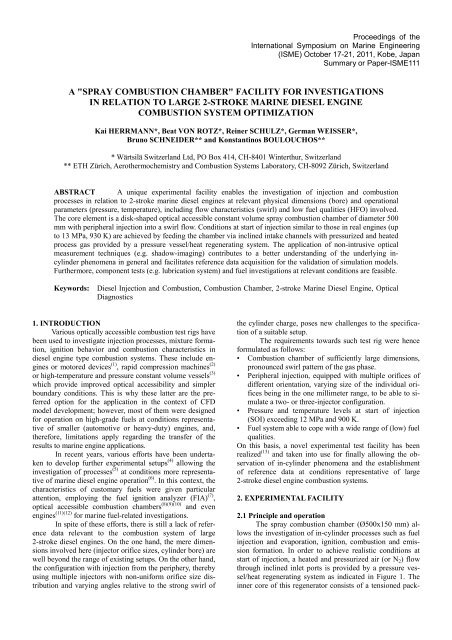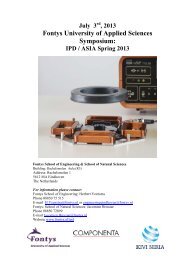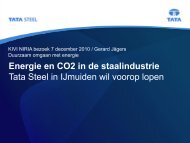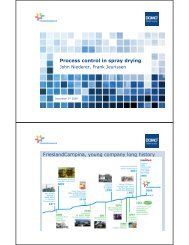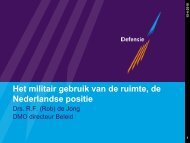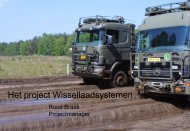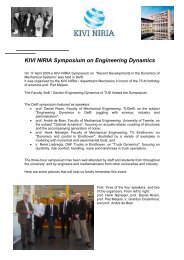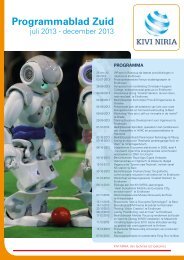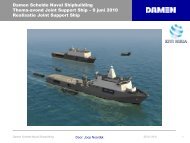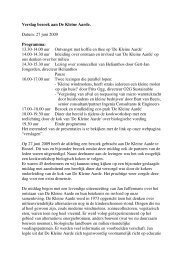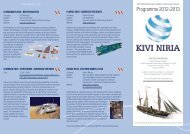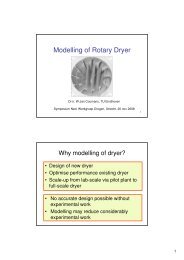"spray combustion chamber" facility for investigations in relation to ...
"spray combustion chamber" facility for investigations in relation to ...
"spray combustion chamber" facility for investigations in relation to ...
You also want an ePaper? Increase the reach of your titles
YUMPU automatically turns print PDFs into web optimized ePapers that Google loves.
and side w<strong>in</strong>dows. The pip<strong>in</strong>g from the <strong>in</strong>jection controlunit on the fuel rail <strong>to</strong> the <strong>in</strong>jec<strong>to</strong>r is separated by a distributionblock which is axis-symmetric <strong>to</strong> the revolvable cover.This offers the advantage <strong>to</strong> adjust the <strong>spray</strong> location directlywith the rotatable <strong>in</strong>jec<strong>to</strong>r so that the measurementposition <strong>for</strong> optical techniques can rema<strong>in</strong> fixed.Fig.4"Injec<strong>to</strong>r-<strong>in</strong>-dummy" configuration.3. OPTICAL MEASUREMENT TECHNIQUES3.1 Shadow-imag<strong>in</strong>gThe <strong>spray</strong> propagation <strong>in</strong>side the chamber has beenvisualized by means of an improved "Shadow-imag<strong>in</strong>g" (15)method. The upper sequence of Figure 5 shows a series ofimages illustrat<strong>in</strong>g the ignition process of a two <strong>spray</strong> configurationat conditions of 9 MPa and 900 K <strong>in</strong> the <strong>spray</strong><strong>combustion</strong> chamber at start of <strong>in</strong>jection. In this case, theignition is occurr<strong>in</strong>g with<strong>in</strong> the observation area at a positionrather on the lee side of the <strong>spray</strong>s and <strong>combustion</strong> isthen spread<strong>in</strong>g both <strong>to</strong>wards their tips and the <strong>in</strong>jec<strong>to</strong>r.These image series are based on a standard backgroundillum<strong>in</strong>ation with an arc lamp light source. Obviously, theflame lum<strong>in</strong>escence is dom<strong>in</strong>at<strong>in</strong>g the background illum<strong>in</strong>ationonce the <strong>combustion</strong> is fully developed. The sensorof the camera gets overexposed and this clearly represents aproblem <strong>for</strong> the visualization of the <strong>spray</strong> <strong>in</strong> the late phase.A solution <strong>for</strong> this problem has been found <strong>in</strong> apply<strong>in</strong>gan alternative illum<strong>in</strong>ation concept, consist<strong>in</strong>g <strong>in</strong> apulsed diode laser (690 nm) light source. Due <strong>to</strong> the veryshort 50 ns laser pulse with<strong>in</strong> a 1 µs exposure time of ahigh-speed CMOS-camera (20 kHz frame rate, 512x512pixel) <strong>in</strong> comb<strong>in</strong>ation with an appropriate narrow band passfilter (CWL 689.1 nm, T 60%, FWHM 10.6 nm), a highsignal-<strong>to</strong>-noise ratio <strong>in</strong> the record<strong>in</strong>gs is achieved. Due <strong>to</strong>the short exposure time, the flame light is almost completelysuppressed and <strong>spray</strong> visualization becomes feasibleeven under reactive conditions. As a consequence, considerably"sharper" images are obta<strong>in</strong>ed and it is possible <strong>to</strong>cont<strong>in</strong>ue observation of <strong>spray</strong>s even after ignition has takenplace. This is demonstrated <strong>in</strong> the lower sequence of Figure5, which refers <strong>to</strong> the same configuration and conditions as<strong>in</strong> the upper and where the propagation of the <strong>spray</strong>s rema<strong>in</strong>sclearly detectable well beyond their ignition.3.2 Mie scatter<strong>in</strong>gThe scatter<strong>in</strong>g of electromagnetic radiation by sphericalparticles is depend<strong>in</strong>g on the particle size relative <strong>to</strong> thelight wavelength λ – the term "Mie-scatter<strong>in</strong>g" is commonlyused <strong>for</strong> sizes larger than 10% of λ. In <strong>combustion</strong> diagnosticsespecially, (fuel) <strong>spray</strong>s and droplets fall <strong>in</strong><strong>to</strong> thissize range. Mie-scatter<strong>in</strong>g basically is an <strong>in</strong>verted shadow-imag<strong>in</strong>gmethod so that <strong>for</strong> the <strong>in</strong>vestigated object noillum<strong>in</strong>ated background is required.Figure 6 shows the Mie-scatter<strong>in</strong>g setup at the <strong>spray</strong><strong>combustion</strong> chamber. In order <strong>to</strong> have sufficient illum<strong>in</strong>ationpower comb<strong>in</strong>ed with a high laser pulse frequency, aNd:YLF laser was employed. It provides a 20 kHz repetitionrate with very short laser pulses (ns) of sufficientenergy which can be synchronized with the exposure timeof the high-speed camera operat<strong>in</strong>g at the same frequency.The laser beam itself has <strong>to</strong> be aligned so that its path isadjusted <strong>to</strong> 50% beam splitters divid<strong>in</strong>g it <strong>in</strong><strong>to</strong> two beamswhich are expanded and shaped by a specific lens system <strong>to</strong>illum<strong>in</strong>ate (around the camera) the desired observation areathrough the front w<strong>in</strong>dow of the <strong>spray</strong> <strong>combustion</strong> chamberFig.6Nd:YLF laser beam alignment with front illum<strong>in</strong>ation <strong>to</strong>per<strong>for</strong>m high-speed Mie-scatter<strong>in</strong>g <strong>spray</strong> record<strong>in</strong>gs.Fig.5Shadow-imag<strong>in</strong>g record<strong>in</strong>gs with regular arc-lamp (<strong>to</strong>prow) and laser background light source (bot<strong>to</strong>m row).4. FUNDAMENTAL INVESTIGATIONSAn extensive number of systematic shadow-imag<strong>in</strong>gmeasurements <strong>for</strong> determ<strong>in</strong><strong>in</strong>g the <strong>spray</strong> evolution and ignitionbehaviour at various chamber conditions (3/6/9 MPa,930 K) and <strong>in</strong>jection parameters (nozzle tip configurationsand fuels) have been per<strong>for</strong>med (15) . The <strong>in</strong>jection pressurehas been set <strong>to</strong> 1000 bar <strong>in</strong> order <strong>to</strong> assure comparable <strong>in</strong>jectionbehaviour as <strong>in</strong> mar<strong>in</strong>e diesel eng<strong>in</strong>e applications.4.1 Qualitative <strong>spray</strong> behaviourFigure 7 shows the s<strong>in</strong>gle-hole nozzle (∅ 0.875 mm)cases with <strong>spray</strong> orientation vary<strong>in</strong>g from counter-swirl,perpendicular <strong>to</strong> the swirl, co-swirl, and a co-swirl <strong>in</strong>jec<strong>to</strong>r-co-axialorientation. The three lower left images orig<strong>in</strong>atefrom two-hole nozzle cases (counter-swirl <strong>to</strong> co-swirl)with identical orifice diameters (∅ 0.875 mm) and vary<strong>in</strong>gangles between the <strong>in</strong>dividual <strong>spray</strong>s. The lower right imagerefers <strong>to</strong> a five <strong>spray</strong> case representative of <strong>in</strong>jec<strong>to</strong>rstypically used on eng<strong>in</strong>es of similar size with pronouncedorifice size distribution (decreas<strong>in</strong>g from ∅ 0.975 mm <strong>to</strong> ∅0.675 mm with co-swirl orientation). The effect of <strong>spray</strong>
9 MPaHFOFig.11 Experimental and simulated <strong>spray</strong> evolution and density.ure 11 exemplarily gives a visual impression of an assembledmeasured <strong>spray</strong> compared <strong>to</strong> its simulated propagationand droplet shadow density (identical data process<strong>in</strong>g)along the <strong>spray</strong> evolution path.In addition <strong>to</strong> the <strong>in</strong>ert measurements <strong>for</strong> determ<strong>in</strong><strong>in</strong>g<strong>spray</strong> morphology (penetration, cone angle) at evaporat<strong>in</strong>ggas conditions, further extensive measurement campaignshave been per<strong>for</strong>med <strong>for</strong> <strong>in</strong>vestigat<strong>in</strong>g the non-evaporat<strong>in</strong>gbehavior at constant density (18) . As <strong>in</strong>dicated <strong>in</strong> Figure 12(left) the <strong>in</strong>jection <strong>spray</strong> at such conditions (non-reactive,non-evaporat<strong>in</strong>g) has been observed up <strong>to</strong> the chamber wall.On the right side of Figure 12 the deflection due <strong>to</strong> the swirlis recognizable.6 MPa9 MPaLFO6 MPaFig.13 Spray evolution with LFO and HFO at two differentchamber pressures at 900 K.5.1 Production eng<strong>in</strong>e fuel <strong>in</strong>jec<strong>to</strong>rsFigure 14 shows two exemplary images of a highspeed (20 kHz) <strong>in</strong>jection record<strong>in</strong>g based on front illum<strong>in</strong>ation<strong>for</strong> visualiz<strong>in</strong>g s<strong>in</strong>gle <strong>spray</strong>s orig<strong>in</strong>at<strong>in</strong>g from the nozzletip of a genu<strong>in</strong>e <strong>in</strong>jec<strong>to</strong>r. The scattered light <strong>in</strong>tensity isproportional <strong>to</strong> the droplet concentration and the square ofthe droplet diameter but a quantitative analysis (dropletsizes) is hardly possible. Nevertheless, the technique is able<strong>to</strong> deliver a lot of <strong>in</strong><strong>for</strong>mation about the <strong>in</strong>jection <strong>spray</strong>s andtheir evolution, such as penetration, cone angle, <strong>in</strong>jec<strong>to</strong>rquality (reproducibility, needle bounc<strong>in</strong>g), and the detectionof the effective (hydraulic) <strong>in</strong>jection start/end.Fig.12 Spray evolution at non-evaporat<strong>in</strong>g conditions.4.3 Initial studies of fuel quality impactFollow<strong>in</strong>g <strong>in</strong>itial experiments with HFO <strong>for</strong> validat<strong>in</strong>gthe functionality and per<strong>for</strong>mance (e.g. reproducibility)of the setup with the separate HFO <strong>in</strong>jection system, firstsets of regular measurements have been per<strong>for</strong>med. In order<strong>to</strong> allow the assessment of fuel quality effects, the <strong>spray</strong>behavior and morphology has been <strong>in</strong>vestigated <strong>for</strong> thesame set of conditions – <strong>in</strong>jection <strong>in</strong><strong>to</strong> air (reactive), chamberpressures 9/6/3 MPa at constant temperature (900K) –as already used <strong>in</strong> the LFO experiments. Figure 13 shows acomparison of <strong>spray</strong> propagation with the two fuel types <strong>for</strong>the 9 and 6 MPa pressure cases. As expected, the penetrationof the <strong>spray</strong>s is largely similar; however, there seem <strong>to</strong>be non-negligible differences <strong>in</strong> the primary breakup of the<strong>spray</strong>, lead<strong>in</strong>g <strong>to</strong> the establishment of a wider angle alreadyclose <strong>to</strong> the <strong>in</strong>jec<strong>to</strong>r tip. This also has an effect on the ignitionlocation, as can be recognized from this data. It rema<strong>in</strong>s<strong>to</strong> be seen if this is a general pattern or rather a consequenceof fac<strong>to</strong>rs that are not yet entirely unders<strong>to</strong>od. Forthis purpose, <strong>in</strong> addition <strong>to</strong> the measurement methods usedso far, future <strong><strong>in</strong>vestigations</strong> will also feature advanced techniquessuch as flame emission spectroscopy.5. COMPONENT TESTSThe versatility of the <strong>spray</strong> <strong>combustion</strong> chamber canalso be used <strong>to</strong> test components (e.g. <strong>in</strong>jec<strong>to</strong>rs) or <strong>to</strong> <strong>in</strong>vestigatethe functionality of subsystems at realistic conditions.Fig.14 Prelim<strong>in</strong>ary front illum<strong>in</strong>ation visualization tests of orig<strong>in</strong>al<strong>in</strong>jection nozzle tips.5.2 Lubricant <strong>in</strong>jec<strong>to</strong>rsAnother important issue related <strong>to</strong> 2-stroke mar<strong>in</strong>ediesel eng<strong>in</strong>e operation is the per<strong>for</strong>mance of the cyl<strong>in</strong>derlubricat<strong>in</strong>g system. For systems based on the <strong>in</strong>jection ofthe lubricant (Figure 15), their per<strong>for</strong>mance is dependent ona variety of design (e.g. number of orifices, diameter <strong>in</strong> theFig.15 Scheme cyl<strong>in</strong>der lubricat<strong>in</strong>g system (right) and prelim<strong>in</strong>arylube oil visualization at different conditions (left).
ange of 0.2 – 1.0 mm) and operational (e.g. <strong>in</strong>jection pressurebetween 20 bar and 80 bar) parameters, which alsoneed <strong>to</strong> be optimized by means of appropriate tests. For thispurpose, such pro<strong>to</strong>type system has been mounted on the<strong>spray</strong> <strong>combustion</strong> chamber and first visualizations of thelube oil jet propagation have been realized (Figure 15 left).6. CONCLUSIONS AND OUTLOOKA new experimental <strong>facility</strong> allow<strong>in</strong>g the <strong>in</strong>vestigationof <strong>spray</strong> and <strong>combustion</strong> processes at conditions typicalof large 2-stroke diesel eng<strong>in</strong>es has been put <strong>to</strong> productiveuse. The results yield valuable <strong>in</strong>sight <strong>in</strong><strong>to</strong> the behaviourof <strong>in</strong>dividual as well as pairs or groups of <strong>spray</strong>s atrelevant conditions <strong>in</strong> terms of pressure, temperature andflow pattern at start of <strong>in</strong>jection. With the recent addition ofa separate <strong>in</strong>jection system <strong>for</strong> HFO, the impact of fuelquality, <strong>in</strong>clud<strong>in</strong>g cus<strong>to</strong>mary mar<strong>in</strong>e fuels, can now be assessed<strong>in</strong> more detail. The results are thoroughly analyzed<strong>for</strong> generat<strong>in</strong>g relevant reference data <strong>for</strong> CFD model developmentand the validation aga<strong>in</strong>st these data has alreadybrought about clear improvements of the predictive qualityof CFD simulations. However, the potential of the experimental<strong>facility</strong> goes well beyond this classical application.It could be shown that it is equally suited <strong>for</strong> test<strong>in</strong>g of keyeng<strong>in</strong>e components such as fuel or lube oil <strong>in</strong>jec<strong>to</strong>rs – itshighly versatile design lends itself <strong>for</strong> a big variety of applications.There<strong>for</strong>e, it will be employed both <strong>for</strong> morefundamental <strong><strong>in</strong>vestigations</strong>, <strong>in</strong>clud<strong>in</strong>g also more advancedexperimental techniques <strong>for</strong> <strong>spray</strong> <strong><strong>in</strong>vestigations</strong>, and <strong>in</strong> thecontext of product development by per<strong>for</strong>m<strong>in</strong>g dedicatedcomponent per<strong>for</strong>mance and system optimization tests.ACKNOWLEDGMENTSThe present work has been conducted as part of theHERCULES-β project with<strong>in</strong> EC's 7th Framework Program,Contract SCP7-GA-2008-217878. F<strong>in</strong>ancial support by theSwiss Federal Office of Energy SFOE Contract 154269,Project 103241) is gratefully acknowledged.REFERENCES(1) Bruneaux G., Verhoeven D., Baritaud T., "High pressurediesel <strong>spray</strong> and <strong>combustion</strong> visualization <strong>in</strong> atransparent model diesel eng<strong>in</strong>e", SAE 1999-01-3648,(1999).(2) Balles A., Heywood J.B., "Fuel-air mix<strong>in</strong>g and diesel<strong>combustion</strong> <strong>in</strong> a rapid compression mach<strong>in</strong>e. SAE880206, (1988).(3) Pikett L.M., Siebers D.L., "Soot <strong>in</strong> diesel fuel jets: effectsof ambient temperature, ambient density, and <strong>in</strong>jectionpressure", Combust. Flame, 138, (2004), pp.114–135.(4) Buchholz B., Pittermann R., Niendorf M., "Measures<strong>to</strong> Reduce Smoke and Particulate Emissions from Mar<strong>in</strong>eDiesel Eng<strong>in</strong>es us<strong>in</strong>g Compact Common Rail Injec<strong>to</strong>rs"",CIMAC Congress (Vienna, Austria), (2007),No. 129.(5) F<strong>in</strong>k C., Frobenius M., Me<strong>in</strong>dl E., Harndorf H., "Experimentaland Numerical Analysis of Mar<strong>in</strong>e Diesel Eng<strong>in</strong>eInjection Sprays under Cold and EvaporativeConditions ", ICLASS Conference (Vail, USA), (2009),No. 222.(6) Tajima H., Kunimitsu M., Sugiura K., Tsuru D., "Developmen<strong>to</strong>f High-Efficiency Gas Eng<strong>in</strong>e throughObservation and Simulation of Knock<strong>in</strong>g Phenomena",CIMAC Congress (Bergen, Norway), (2010), No. 213.(7) Takeda A., Nakatani H., Shimizu E., Ura T., Ka<strong>to</strong> T.,Suzuki D., Miyano H., "The ignition and the <strong>combustion</strong>quality by FIA (Fuel Ignition Analyzer) of actualMFO and the countermeasure aga<strong>in</strong>st the MFO with<strong>in</strong>ferior quality", CIMAC Congress (Vienna, Austria),(2007), No. 199.(8) Tomita E., Yamaguchi A., Takeuchi T., Yamamo<strong>to</strong> Y.,Mor<strong>in</strong>aka K., "Optical Combustion Analyzer (OCA)<strong>for</strong> Evaluation of Combustion Characteristics of BunkerFuel Oils", CIMAC Congress (Bergen, Norway),(2010), No. 247.(9) F<strong>in</strong>k C., Buchholz B., Niendorf M., Harndorf H., "InjectionSpray Analyses from Medium Speed Eng<strong>in</strong>esus<strong>in</strong>g Mar<strong>in</strong>e Fuels", ILASS Conference (Como, Italy),(2008), No. 102.(10) Okada H., Tsukamo<strong>to</strong> T., Ohtsuka T. Sasaki H., "Aspectsof Emulsified Fuel Spray Combustion <strong>in</strong> aHigh-pressure and High-temperature Atmosphere",CIMAC Congress (Bergen, Norway), (2010), No. 281.(11) Takasaki K., Hirata J., Sugiura K., Kurosawa T., Hashimo<strong>to</strong>T., Miyano H., Takeda A., Suzuki D., HayashiT. Tajima H., "Problem <strong>in</strong> the near future - Low sulfurand low grade bunker fuel", CIMAC Congress (Vienna,Austria), (2007), No. 74.(12) Takasaki K., Okazaki K., Yamanishi D., Sugiura K.,Baba S., Tanaka H., " A step <strong>to</strong> reduce SO x emissionfrom ships – Improvement <strong>in</strong> <strong>combustion</strong> ofhigh-aromatic and low-sulfur distillate fuel", CIMACCongress (Bergen, Norway), (2010), No. 31.(13) Herrmann K., Schulz R., and Weisser G., "Developmen<strong>to</strong>f a Reference Experiment <strong>for</strong> Large Diesel Eng<strong>in</strong>eCombustion System Optimization", CIMAC Congress(Vienna, Austria), (2007), No. 98(14) Herrmann K., Kyrta<strong>to</strong>s A., Schulz R., and Weisser G.,"Validation and Initial Application of a Novel SprayCombustion Chamber Representative of Large Two-Stroke Diesel Eng<strong>in</strong>e Combustion Systems", ICLASSConference (Vail, USA), (2009), No. 005.(15) Herrmann K., von Rotz B., Schulz R., Weisser G.,Boulouchos K., and Schneider B., "Reference DataGeneration of Spray Characteristics <strong>in</strong> Relation <strong>to</strong>Large 2-Stroke Mar<strong>in</strong>e Diesel Eng<strong>in</strong>es Us<strong>in</strong>g a NovelSpray Combustion Chamber Concept", ILASS Conference(Brno, Czech Republic), (2010), No. 139.(16) Schneider B., PhD thesis, "Experimentelle Untersuchungenzur Spraystruktur <strong>in</strong> transienten, verdampfendenund nicht verdampfenden Brenns<strong>to</strong>ffstrahlen unterHochdruck", ETH Zurich, (2003), No. 15004.(17) Reitz, R.D., Diwakar. R., "Structure of High PressureFuel Sprays", SAE 870598, (1987).(18) Von Rotz B., Herrmann K., Weisser G., Catt<strong>in</strong> M.,Bolla M., and Boulouchos K., "Impact of Evaporation,Swirl and Fuel Quality on the Characteristics of Spraystypical of Large 2-Stroke Mar<strong>in</strong>e Diesel Eng<strong>in</strong>e CombustionSystems", ILASS Conference (Es<strong>to</strong>ril, Portugal),(2011).


